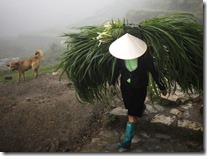 More rural Vietnamese are struggling with meager diets, less agricultural land and lower wages during the 2008-2010 period, according to recently released data.
More rural Vietnamese are struggling with meager diets, less agricultural land and lower wages during the 2008-2010 period, according to recently released data.
The study, which was released on Wednesday (July 6), is based on evidence gathered in the former Ha Tay, Lao Cai, Phu Tho, Dien Bien, Lai Chau, Nghe An, Quang Nam, Khanh Hoa, Dak Lak, Dak Nong, Lam Dong and Long An provinces.
The study was jointly conducted by the Central Institute for Economic Management, the Institute for Policy and Strategy for Agriculture and Rural Development, Institute of Labor Science and Social Affairs and the University of Copenhagen, documenting the well-being of rural households focusing on access and use of productive resources.
According to the study, the percentage of households classified as poor by the Ministry of Labor, War Invalids and Social Affair has declined from 23 percent in 2006, to 20 percent in 2008 and 16 percent in 2010.
However, Dien Bien, Khanh Hoa and Long An were three provinces where poverty rates are higher than in 2006.
Researchers also reported a significant proportion of landless households. Khanh Hoa topped the list with 18.4 percent, followed by Long An with 9.4 percent and Dak Lak with 8.9 percent.
There was a small increase in the diversity of the diet of households between 2008 and 2010 while some of the provinces reported a significant downward trend including Quang Nam and the portion of Hanoi that was formerly known as Ha Tay.
“As a diverse diet is an important contributing factor of a person’s health status, and is especially important for small children, the small increase is a positive step but some [poor] provinces are lagging behind,” the study’s authors wrote.
Although there was an increase in the average household income, that figure remains low. The authors of the study reported that many rural residents have had to get involved in diverse activities to increase their incomes.
The average annual household income in 2010 was VND80.9 million (US$3,930)—a statistically significant increase from the 2008 average of VND52.7 million, according to the study.
“It is common that rural households in developing countries engage in several income-generating activities as a means of diversifying risk,” the study said. “This is particularly the case for households that are regularly exposed to income shocks.”
The authors reported that this tendency has deprived certain households of growth opportunities. They recommended economic specialization and promoted larger-scale operations to increase profitability and productivity.
Luu Duc Khai, head of the Central Institute for Economic Management’s Rural Development Policy Division, said that the authors of the study are considering the findings as they draft a policy proposal that they’ll submit to the central government.
“Poor rural households are living on incomes derived from agriculture which has decreased,” he said. “Policymakers should take immediate action to avoid impoverishing them.”
Khai said that farmland has been drastically reduced by urbanization.
“Despite supportive policies from the government like compensation and vocational training, a decrease in rural land will have significant impact on their livelihood,” he said.
He stressed that there should be more jobs for farmers that don’t require them to relocate to urban areas –such as food processing.

Deprecated: strpos(): Passing null to parameter #1 ($haystack) of type string is deprecated in /home/agriviek8Qv/agriviet.net/public_html/wp-includes/comment-template.php on line 2522